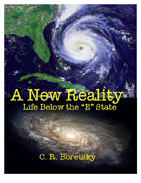"I view all things as transitional. There is no beginning and there is no end. It's what's in between that is the interesting part."

 |
A New Reality: Life Below the 'E' State by C.R. Boretsky Trafford Publishing
book review by Wendy Strain
In this book, Boretsky describes a sense of synergy he feels is taking place between science and religion in our 21st century timeframe. He starts his book with the first line of the Bible. He uses this quote to illustrate how the way it is written automatically establishes our thinking along a linear plane.
By discussing what science and technology have taught us about the nature of our world and our universe, he shows why this single perspective has led us down a too narrowly defined path that prevents us from gaining access to truth. This discussion is based heavily on verifiable mathematics and understood principles of physics interspersed lightly with evidence from the Bible as the most familiar text to a Western audience. When reading this book, it is helpful to have some scientific background or a relatively complex scientific theory reference book at hand to inform Boretsky's more complex jumps in reasoning.
The early discussion, within the first half of the book, focuses on what we understand of truth as a philosophical concept and the natures of matter and energy. The argument builds regarding the nature of nature and humankind's uniqueness in the grand design. Laid out in basic logic and accessible language, the argument itself is not difficult to follow as long as the science is understood. Frequent historical and physical science references help to illustrate each point.
One really interesting element of this book is the way in which it reflects the passage of time and the influence this has had on the shaping of the author's thinking. Originally written between 1995 and 1997 but not published until 2004, the current volume was only recently published. This gave the author the opportunity to revise the chapters based on new knowledge acquired in the intervening years. Rather than simply change sections he no longer agrees with or otherwise would alter, Boretsky includes an additional preface to the new volume set in a font clearly different from the original. Throughout the book, this shift into a different font represents new material added with this volume. Using this technique, the author offers to expand the conversation, asking questions, pointing out differences, and adding to the scientific or spiritual understandings he has encountered.
For those more interested in the science/religion connection, it is necessary to understand at least some of the author's perspective on the scientific principles discussed in the first half of the book in order to clearly envision his concept of God and how He fits into scientific theory. The author's ideas align with some of the new age theories regarding spiritual matter, yet he demonstrates how he has reached his conclusions through a highly logical, scietific path by consistently referring back to the ideas mentioned in earlier chapters. What makes his discussion refreshing is the way in which he also makes consistent reference to more traditional concepts of God and spirit, demonstrating how they also fit in seamlessly with both the scientific concepts outlined in the first part of the book and the expanded viewpoints of new age ideas.
Some of the moral discussions undertaken by the author may upset some readers as being too controversial, but the purpose of the book is not to settle the minds of the scientists or the religious. Instead, this book is intended to provoke thought, introduce ideas into the greater discussion, and have those who are open-minded enough consider their relative merits and implications. In keeping with this objective, Boretsky includes some minor discussion of ancient end-of-the-world theory and more extensive discussion of UFO sightings. The book also covers topics such as the unified theory and some possible solutions to some of mankind's more distressing self-created problems